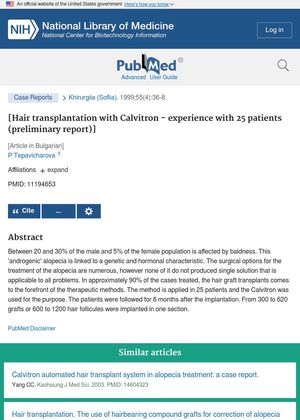TLDR The Calvitron method for hair transplantation was effective in about 90% of the 25 patients treated for hair loss.
In 1998, a study was conducted on 25 patients using the Calvitron method for hair transplantation to treat androgenic alopecia, a condition affecting 20-30% of the male and 5% of the female population. The patients were monitored for 6 months post-implantation. The study found that hair graft transplants were the most effective treatment in about 90% of the cases. Each patient received between 300 to 620 grafts, or 600 to 1200 hair follicles, in one session. The study concluded that while there were numerous surgical options for treating alopecia, none provided a single solution applicable to all problems.
 February 2022 in “International Journal of Research in Dermatology”
February 2022 in “International Journal of Research in Dermatology” Topical minoxidil is the primary treatment for female pattern hair loss in India.
 13 citations
,
November 2018 in “Annals of Plastic Surgery”
13 citations
,
November 2018 in “Annals of Plastic Surgery” Nonshaven follicular unit extraction is a good hair transplant option that doesn't require shaving and can transplant up to 3000 grafts daily.
 27 citations
,
September 2018 in “Skin appendage disorders”
27 citations
,
September 2018 in “Skin appendage disorders” Hair transplantation may work for some types of scarring alopecia, but results vary and more research is needed.
July 2013 in “International Journal of Dermatology and Venereology” The ZMY-1 system makes hair transplants faster without losing safety or effectiveness.
12 citations
,
February 2008 in “CRC Press eBooks” The document explains different hair and scalp conditions and their treatments.
 24 citations
,
September 2002 in “Dermatologic Surgery”
24 citations
,
September 2002 in “Dermatologic Surgery” The place where hair is transplanted can affect its growth and survival rates.
 5 citations
,
March 1985 in “Head & Neck Surgery”
5 citations
,
March 1985 in “Head & Neck Surgery” Combining scalp reduction and hair transplants improves coverage and appearance for male baldness.





